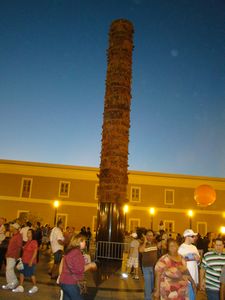Advertisement
Published: January 19th 2011

 Plaza
Plaza
This plaza was loacted in the heart of the San Sebastian festivalToday was a day of exploration of Old San Juan and the human geography aspects. San Juan is considered a primate city, meaning there is more living within the city itself than the island. In the walking tour of San Juan, there are over 46 destinations, all similar and unique in their own ways. We managed to see a few key sites, such as Fort El Morro, Fort San Cristobal, and many Plazas as well as a church and the cemetery of San Juan.
The Plaza’s are numerous throughout San Juan, mainly because of their communal feeling. People of San Juan are largely community based. Evidence of that could be the multiple individual festivals I’ve encountered on my trip here in each city. Each individual plaza holds its own historical value, such as the Plaza de Hostos which honors Eugenio Maria de Hostos, the avid supporter of the independence movement for Puerto Rico and Cuba. Or Plazuela de la Rogativa which is in honor of the woman and children that marched through the streets of San Juan praying to the gods for food and saving since Ralph Abercrombie of the British armada was starving the city. The parade caused such

 Plaza
Plaza
This is another plaza located in Old San Juana ruckus, Abercrombie thought the city had called in reinforcements and retreated from the island. Whether the plazas are a site of honor to a person or to a movement, each holds a site of community gathering.
Fuerte San Felipe del Morro is on the northwestern-most point of the islet of San Juan, Puerto Rico. Named in honor of King Philip II of Spain was designed to guard the entrance to the San Juan Bay, and defend the city of Old San Juan from seaborne enemies. In 1983, during the Reagan Administration, the fort was declared a World Heritage Site by the United Nations in conjunction with the San Juan National Historic Site. During the Spanish occupation of the island, El Morro survived several attacks from foreign powers on various occasions. In 1595, Sir Francis Drake from England attacked San Juan with his fleet. He failed, however, when Spanish gunners shot a cannonball through his cabin. In 1598, the British attacked again led by George Clifford. Clifford succeeded because he entered San Juan through land instead of entering through the San Juan Bay and El Morro. However, an epidemic of dysentery forced him to flee the island. The final

 Plazuela de la Rogativa
Plazuela de la Rogativa
Constructed in 1971 by Lindsay Daen.attack on El Morro was in 1898. During the Spanish-American War, US Warships fired on the lighthouse and destroyed it - the lighthouse that stands there today was built in 1908. In 1983 the United Nations declared El Morro a World Heritage Site.
Castillo de San Cristóbal is the largest fortification built by the Spanish in the New World. When it was finished in 1783, it covered about 27 acres of land and basically wrapped around the city of San Juan. One of the guerites (sentry boxes) at Fort San Cristóbal is called "The Devil's Guerite”. This particular guerite is one of the oldest parts of the fort being built in 1634.
The Catedral de San Juan was a Cathedral which we stopped at. This cathedral was a grand site. I have seen many gothic style cathedrals in Ireland and this rivaled them. The historical and culture influences where apparent to whoever entered the church. With historical figures in tombs and plaques all around the church, it was not hard to decipher how this place was a huge influence of culture.
Cementerio de San Juan is a famous and populated cemetery. It is a historic landmark that

 Paseo de la Princesa, Antigua Carcel, Raices Fountain
Paseo de la Princesa, Antigua Carcel, Raices Fountain
Orginally created in 1853 and restored in the 19th century, the bronze fountain celebrates the Puerto Rican rich culture diversity and heritage.was the first of its type developed in San Juan. Initially, it was intended as a resting-place for famous war veterans from the colonial era. In this cemetery you can find important names from the 19th and early 20th century. The grounds are just outside El Morro and overlook the sea.
Advertisement
Tot: 0.074s; Tpl: 0.011s; cc: 10; qc: 52; dbt: 0.0416s; 1; m:domysql w:travelblog (10.17.0.13); sld: 1;
; mem: 1.1mb

 Plaza
Plaza
 Plaza
Plaza
 Plazuela de la Rogativa
Plazuela de la Rogativa 
 Paseo de la Princesa, Antigua Carcel, Raices Fountain
Paseo de la Princesa, Antigua Carcel, Raices Fountain










